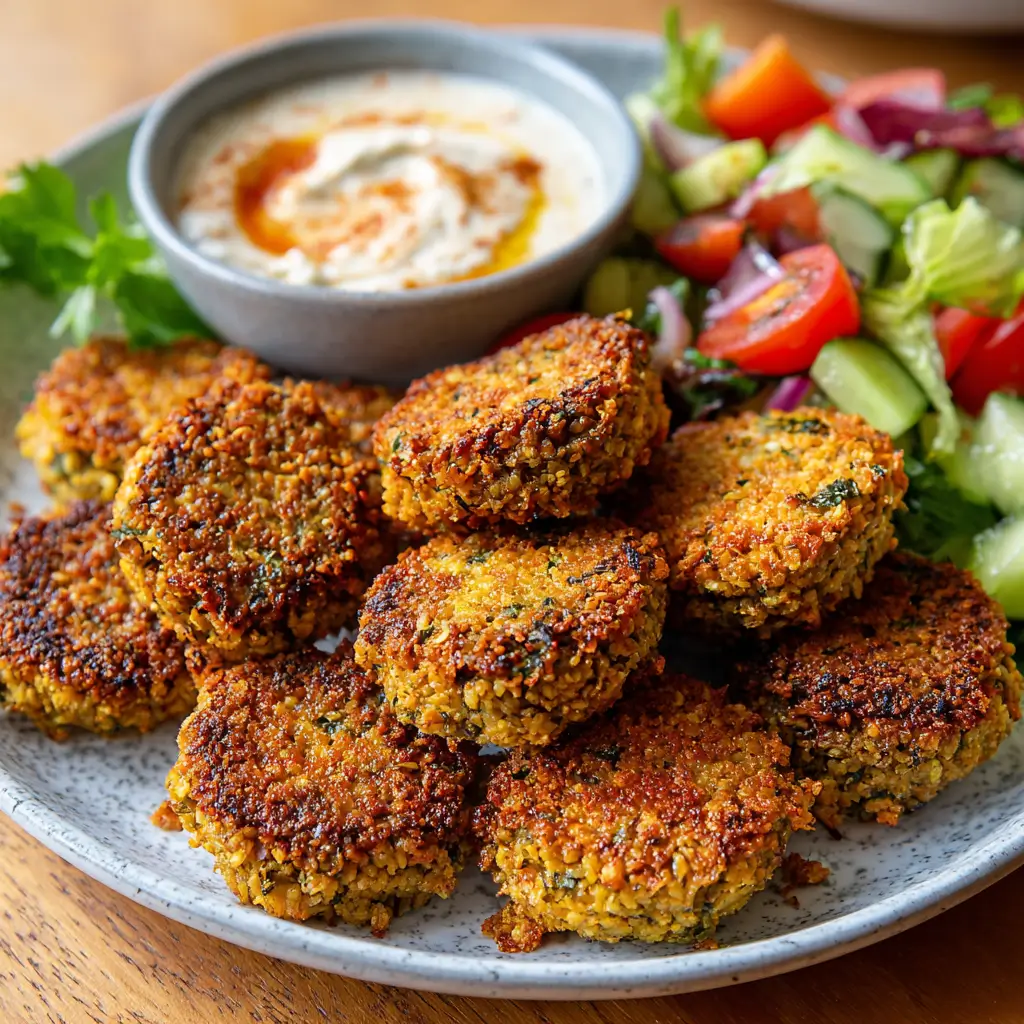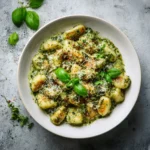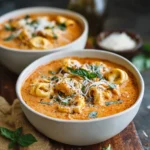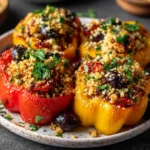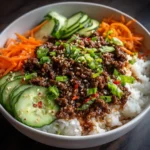Crispy Baked Falafel: A Healthy, Flavor-Packed Twist on a Middle Eastern Classic
Falafel, the beloved deep-fried chickpea fritter, has long been a staple in Middle Eastern cuisine, enjoyed across countries like Lebanon, Egypt, Israel, and Palestine. Traditionally served in pita bread with tahini sauce, fresh vegetables, and pickles, falafel is cherished for its bold flavors, satisfying texture, and plant-based goodness. However, while traditional falafel is undeniably delicious, it’s often deep-fried—making it high in fat and calories. Enter Crispy Baked Falafel: a healthier, oven-baked alternative that retains all the flavor and crunch without the excess oil. This version is perfect for health-conscious food lovers, meal preppers, vegans, vegetarians, and anyone seeking a nutritious yet indulgent snack or meal component. In this comprehensive guide, we’ll dive into the history of falafel, explore its ingredients, provide a detailed step-by-step recipe, share expert tips, offer customization ideas, discuss nutritional benefits, and answer frequently asked questions—all to help you master the art of making irresistibly crispy baked falafel right in your own kitchen.
The History of Falafel
The origins of falafel are both ancient and debated, with multiple cultures laying claim to its invention. While many associate falafel with Israel today, its roots stretch far deeper into Middle Eastern culinary history. Some historians believe falafel originated in Egypt over 1,000 years ago, where Coptic Christians may have created a fava bean-based version as a hearty meat substitute during Lent. The word “falafel” itself likely comes from the Arabic word “filfil,” meaning “spicy,” suggesting an early emphasis on bold seasoning.
Over time, as trade routes expanded and populations migrated, falafel evolved. Chickpeas gradually replaced fava beans in many regions, especially in Lebanon and Syria, due to their wider availability and smoother texture. By the 20th century, falafel had become a street food sensation throughout the Levant. It was eventually adopted and popularized globally by Israeli cuisine, often served in pita with salads, pickled vegetables, and creamy sauces like tahini and amba.
Today, falafel is celebrated not only for its cultural significance but also for being a naturally vegan, protein-rich, and fiber-filled food. As global interest in plant-based eating grows, so does the innovation around falafel—including the now-popular baked version, which offers a lighter take on this timeless favorite.
Ingredients Breakdown: What Makes Crispy Baked Falafel So Good?
The magic of falafel lies in the harmony of simple, wholesome ingredients. Unlike traditional recipes that rely on frying for crispiness, our baked version uses smart ingredient choices and preparation techniques to achieve golden-brown perfection without oil-drowning. Here’s a breakdown of each key component:
- Dried Chickpeas (NOT canned): This is crucial. Dried chickpeas must be soaked overnight because they hold their structure better when blended raw, creating a denser, more cohesive mixture that bakes well. Canned chickpeas are too soft and watery, leading to mushy falafel that falls apart.
- Onion and Garlic: These aromatics add depth and savory umami flavor. Red onion is preferred for its mild sweetness and vibrant color.
- Fresh Herbs (Parsley, Cilantro): Essential for authenticity and brightness. They infuse the falafel with a refreshing herbal note that balances the spices.
- Ground Spices (Cumin, Coriander, Paprika): Warm, earthy cumin is the backbone of falafel flavor. Coriander adds citrusy complexity, while paprika contributes mild heat and rich color.
- Baking Powder: A secret weapon! It helps create air pockets during baking, giving the interior a light, fluffy texture while enhancing exterior crispiness.
- Breadcrumbs or Oat Flour: Acts as a binder and helps absorb moisture, improving texture and aiding browning. Use gluten-free oats if needed.
- Lemon Juice: Adds acidity that brightens the overall taste and enhances herb freshness.
- Olive Oil (minimal): Just a small amount brushed on top ensures a glossy, crispy crust without deep-frying.
Optional additions include ground coriander seed, cayenne pepper for heat, or even a pinch of cardamom for floral warmth—each adding a personal touch to your batch.
Step-by-Step Recipe: How to Make Crispy Baked Falafel at Home
Follow these detailed instructions to make perfectly textured, golden-brown baked falafel every time.
Ingredients
- 1 cup dried chickpeas, soaked in water overnight (do not cook)
- 1 small red onion, roughly chopped
- 4 cloves garlic, minced
- 1 cup fresh parsley, tightly packed, stems removed
- 1 cup fresh cilantro, tightly packed, stems removed
- 1 tsp ground cumin
- 1 tsp ground coriander
- 1 tsp smoked paprika
- 1/2 tsp black pepper
- 1 tsp salt (adjust to taste)
- 1 tbsp lemon juice
- 2–3 tbsp breadcrumbs or oat flour (gluten-free if needed)
- 1 tsp baking powder
- 1–2 tsp olive oil (for brushing)
Directions
- Soak the Chickpeas: Place dried chickpeas in a large bowl and cover with at least 3 inches of cold water. Soak for 18–24 hours. Do not cook them. Drain and rinse thoroughly before use.
- Preheat Oven & Prepare Baking Sheet: Preheat your oven to 375°F (190°C). Line a baking sheet with parchment paper or a silicone mat. Lightly grease it or brush with a tiny bit of oil to prevent sticking.
- Blend Ingredients: In a food processor, combine soaked chickpeas, onion, garlic, parsley, cilantro, cumin, coriander, paprika, black pepper, salt, and lemon juice. Pulse until the mixture resembles coarse sand. Scrape down the sides as needed. Avoid over-blending into a paste.
- Add Binders: Add breadcrumbs (or oat flour) and baking powder. Pulse 5–6 times just until the mixture begins to clump together. It should hold its shape when pinched but still be slightly crumbly.
- Rest the Mixture: Transfer the mixture to a bowl and let it rest for 15–30 minutes. This allows the breadcrumbs to absorb moisture and improves binding.
- Form the Falafel: Using a tablespoon or small scoop, portion the mixture. Roll into balls (about 1.5 inches in diameter) or flatten slightly into patties for better surface contact and crispiness.
- Arrange on Tray: Place formed falafel on the prepared baking sheet, leaving space between each for even cooking.
- Lightly Brush with Oil: Use a pastry brush to lightly coat the tops of each falafel with olive oil. This promotes browning and crispness.
- Bake: Bake for 20 minutes, then carefully flip each falafel using a spatula. Return to the oven and bake for another 15–20 minutes, or until deeply golden and crisp on the outside.
- Cool Slightly: Let falafel rest for 5 minutes after baking. This helps them firm up and retain their shape when handled.
Tips for Perfect Crispy Baked Falafel Every Time
- Never Use Canned Chickpeas: This cannot be stressed enough. Canned chickpeas contain too much moisture and will result in soggy, falling-apart falafel.
- Don’t Over-Process: Aim for a grainy, dough-like texture—not hummus. Over-blending leads to dense falafel.
- Chill Before Baking (Optional): For firmer texture, refrigerate the shaped falafel for 30 minutes before baking. This helps them hold shape better.
- Use a Wire Rack (Optional): For extra crispiness all around, place falafel on a wire rack set over a baking sheet. This allows hot air to circulate evenly.
- Flip Halfway Through: Flipping ensures even browning and maximum crunch on both sides.
- High Heat Works Best: Stick to 375°F–400°F. Lower temperatures steam rather than crisp the exterior.
- Season Well: Taste the mixture (raw chickpeas are safe when soaked!) and adjust salt and spices before shaping.
Variations and Customizations
One of the joys of homemade falafel is the ability to customize it to your taste. Here are some creative twists:
- Gluten-Free: Replace breadcrumbs with almond flour, ground flaxseed, or certified gluten-free oat flour.
- Herb Variations: Try dill, mint, or basil for a unique aromatic profile.
- Spice It Up: Add 1/2 tsp cayenne, harissa paste, or crushed red pepper flakes for a fiery kick.
- Beet or Spinach Falafel: Blend in cooked, drained beets or spinach for colorful, nutrient-boosted versions.
- Low-Sodium: Reduce salt and boost flavor with extra lemon zest, garlic, or smoked paprika.
- Mini Appetizers: Make bite-sized falafel balls for party platters or mezze trays.
- Air Fryer Option: Cook at 370°F for 12–15 minutes, flipping halfway. Spray lightly with oil for crispness.
Health Considerations and Nutritional Value
Crispy baked falafel isn’t just tasty—it’s a powerhouse of nutrition. Here’s why it deserves a spot in a balanced diet:
- High in Plant-Based Protein: Chickpeas provide about 7–9 grams of protein per ½ cup, making falafel a satisfying meat alternative.
- Rich in Fiber: Promotes digestive health, stabilizes blood sugar, and supports satiety. One serving delivers ~5g of fiber.
- Packed with Vitamins & Minerals: Contains folate, iron, manganese, phosphorus, and vitamin B6—nutrients vital for energy metabolism and cellular function.
- Antioxidant-Rich: Fresh herbs like parsley and cilantro are loaded with antioxidants and anti-inflammatory compounds.
- Heart-Healthy Fats: Minimal oil usage keeps saturated fat low, supporting cardiovascular wellness.
- Diabetes-Friendly: Low glycemic index due to high fiber and protein content helps prevent blood sugar spikes.
- Vegan & Vegetarian Friendly: Naturally free from animal products and easily adaptable to various dietary needs.
Nutrition Estimate (per serving, about 3 falafel balls):
Calories: ~180 | Protein: 8g | Carbohydrates: 25g | Fiber: 5g | Fat: 5g (mostly unsaturated) | Sodium: 300mg (adjustable)
Frequently Asked Questions (FAQ)
Can I freeze baked falafel?
Yes! Cool completely, then store in an airtight container or freezer bag for up to 3 months. Reheat in oven at 350°F for 10–15 minutes for best texture.
Why did my falafel fall apart?
Most common causes: using canned chickpeas, over-processing the mix, skipping the resting step, or not using enough binder. Make sure the mixture holds together when squeezed.
Can I make falafel ahead of time?
Absolutely. Shape the falafel and refrigerate (unbaked) for up to 24 hours before baking. You can also fully bake, cool, and refrigerate for 3–4 days.
Is falafel gluten-free?
Naturally yes—but check your breadcrumbs or use gluten-free alternatives to ensure safety.
What do I serve with baked falafel?
Classic pairings include warm pita, hummus, tabbouleh, cucumber-tomato salad, pickled turnips, shredded lettuce, sliced tomatoes, and tahini sauce.
Can I bake falafel without any oil?
Yes, though a light brush enhances crispiness. For oil-free, skip brushing and bake on parchment; expect slightly less browning.
Are baked falafels kid-friendly?
Many children love the crunchy texture and mild spice. Serve in pita sandwiches or as finger food with yogurt dipping sauce.
Summary
Crispy Baked Falafel delivers all the flavor and texture of traditional fried falafel with significantly less fat and more nutritional benefits. Made from scratch with soaked chickpeas, fresh herbs, and warming spices, this oven-baked version is healthy, easy to customize, and perfect for wraps, salads, or snacking.
Whether you’re following a plant-based diet, looking for gluten-free options, or simply craving a wholesome comfort food, this foolproof recipe brings the vibrant tastes of the Middle East straight to your table—with minimal cleanup and maximum satisfaction.
